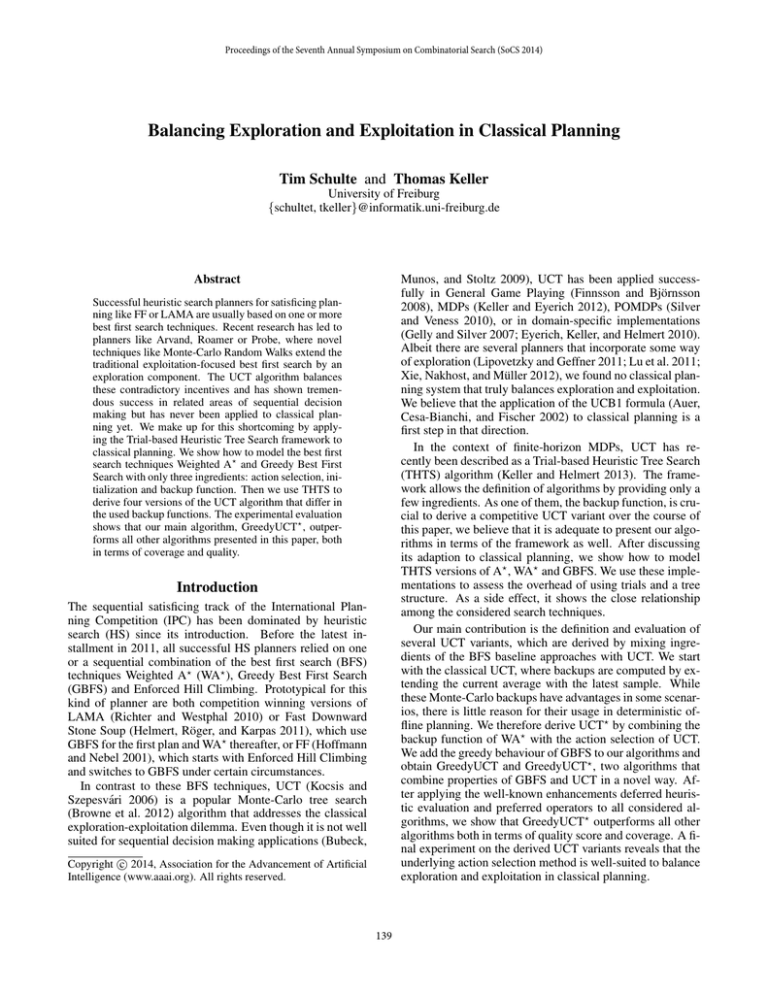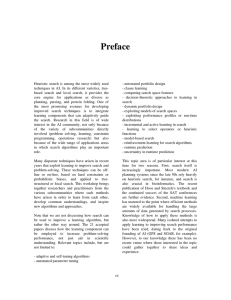
Proceedings of the Seventh Annual Symposium on Combinatorial Search (SoCS 2014)
Balancing Exploration and Exploitation in Classical Planning
Tim Schulte and Thomas Keller
University of Freiburg
{schultet, tkeller}@informatik.uni-freiburg.de
Abstract
Munos, and Stoltz 2009), UCT has been applied successfully in General Game Playing (Finnsson and Björnsson
2008), MDPs (Keller and Eyerich 2012), POMDPs (Silver
and Veness 2010), or in domain-specific implementations
(Gelly and Silver 2007; Eyerich, Keller, and Helmert 2010).
Albeit there are several planners that incorporate some way
of exploration (Lipovetzky and Geffner 2011; Lu et al. 2011;
Xie, Nakhost, and Müller 2012), we found no classical planning system that truly balances exploration and exploitation.
We believe that the application of the UCB1 formula (Auer,
Cesa-Bianchi, and Fischer 2002) to classical planning is a
first step in that direction.
In the context of finite-horizon MDPs, UCT has recently been described as a Trial-based Heuristic Tree Search
(THTS) algorithm (Keller and Helmert 2013). The framework allows the definition of algorithms by providing only a
few ingredients. As one of them, the backup function, is crucial to derive a competitive UCT variant over the course of
this paper, we believe that it is adequate to present our algorithms in terms of the framework as well. After discussing
its adaption to classical planning, we show how to model
THTS versions of A? , WA? and GBFS. We use these implementations to assess the overhead of using trials and a tree
structure. As a side effect, it shows the close relationship
among the considered search techniques.
Our main contribution is the definition and evaluation of
several UCT variants, which are derived by mixing ingredients of the BFS baseline approaches with UCT. We start
with the classical UCT, where backups are computed by extending the current average with the latest sample. While
these Monte-Carlo backups have advantages in some scenarios, there is little reason for their usage in deterministic offline planning. We therefore derive UCT? by combining the
backup function of WA? with the action selection of UCT.
We add the greedy behaviour of GBFS to our algorithms and
obtain GreedyUCT and GreedyUCT? , two algorithms that
combine properties of GBFS and UCT in a novel way. After applying the well-known enhancements deferred heuristic evaluation and preferred operators to all considered algorithms, we show that GreedyUCT? outperforms all other
algorithms both in terms of quality score and coverage. A final experiment on the derived UCT variants reveals that the
underlying action selection method is well-suited to balance
exploration and exploitation in classical planning.
Successful heuristic search planners for satisficing planning like FF or LAMA are usually based on one or more
best first search techniques. Recent research has led to
planners like Arvand, Roamer or Probe, where novel
techniques like Monte-Carlo Random Walks extend the
traditional exploitation-focused best first search by an
exploration component. The UCT algorithm balances
these contradictory incentives and has shown tremendous success in related areas of sequential decision
making but has never been applied to classical planning yet. We make up for this shortcoming by applying the Trial-based Heuristic Tree Search framework to
classical planning. We show how to model the best first
search techniques Weighted A? and Greedy Best First
Search with only three ingredients: action selection, initialization and backup function. Then we use THTS to
derive four versions of the UCT algorithm that differ in
the used backup functions. The experimental evaluation
shows that our main algorithm, GreedyUCT? , outperforms all other algorithms presented in this paper, both
in terms of coverage and quality.
Introduction
The sequential satisficing track of the International Planning Competition (IPC) has been dominated by heuristic
search (HS) since its introduction. Before the latest installment in 2011, all successful HS planners relied on one
or a sequential combination of the best first search (BFS)
techniques Weighted A? (WA? ), Greedy Best First Search
(GBFS) and Enforced Hill Climbing. Prototypical for this
kind of planner are both competition winning versions of
LAMA (Richter and Westphal 2010) or Fast Downward
Stone Soup (Helmert, Röger, and Karpas 2011), which use
GBFS for the first plan and WA? thereafter, or FF (Hoffmann
and Nebel 2001), which starts with Enforced Hill Climbing
and switches to GBFS under certain circumstances.
In contrast to these BFS techniques, UCT (Kocsis and
Szepesvári 2006) is a popular Monte-Carlo tree search
(Browne et al. 2012) algorithm that addresses the classical
exploration-exploitation dilemma. Even though it is not well
suited for sequential decision making applications (Bubeck,
c 2014, Association for the Advancement of Artificial
Copyright Intelligence (www.aaai.org). All rights reserved.
139
Algorithm 1 THTS for classical planning
1: procedure THTS()
2:
while time allows and no plan found do
3:
PERFORM T RIAL ()
4:
return the plan
5: procedure PERFORM T RIAL()
6:
n ← n0
7:
while n is initialized do
8:
n ← SELECTACTION(n)
9:
if s(n) ∈ S ? then
10:
extract plan and return
11:
INITIALIZE N ODE (n)
12:
backupQueue.insert(n)
13:
while backupQueue is not empty do
14:
n ← backupQueue.pop()
15:
BACKUP (n)
16:
if n 6= n0 then
17:
backupQueue.insert(par(n))
Action Selection
Initialization
Backup Function
Figure 1: Ingredients of THTS.
is at most one node for each state s ∈ S, we frequently refer to nodes with the name of the associated state and vice
versa. In the following, we assume that search trees consist
of nodes n = hs, N , f, v, li, where v ∈ N is the number
of visits and l is a binary attribute that is used to mark a
node as locked. We denote the set of applicable actions in
state s(n) with O(n) ⊆ O. If the application of operator o
leads from state s(n) to s(n0 ), we refer to its cost by c(n, n0 )
rather than c(o). Path costs from the root node n0 to a node
n are denoted with g(n) and the parent of a node n is referred to by par(n). Note that path costs are not stored in
search nodes, but are computed on demand. We furthermore
assume that the minimum over a set of nodes (the arg min) is
an unambiguous node (ties are broken uniformly at random
if necessary).
Initially, the explicit tree contains only the root node n0 ,
a node with s(n0 ) = s0 . Each trial adds one or more nodes
to the tree (it explicates them). Trials are performed as long
as a time constraint allows and as long as no plan has been
found. In the first phase of each trial, the explicit tree is traversed from the root node n0 to a tip node by applying action selection to each encountered node. Once a tip node has
been reached, an initialization procedure adds nodes to the
explicit tree and initializes the value estimate with a heuristic function. If a node represents a goal state it is marked as
locked and if it represents a dead end it is ignored and not inserted into the tree. In the third phase of the trial, the backup
function is called for all nodes in the backup queue. Since
the backup queue is such that it orders nodes according to
their g-value (states with higher g-values have higher priority), the backup is performed in reverse order, which allows
the propagation of collected information through the whole
tree. The trial finishes when the backup function is called
on the root node. Figure 1 gives an overview how the three
ingredients of THTS algorithms are connected.
Background
We are interested in planning tasks Π = hV, s0 , S ? , O, i as
defined by Helmert (2009), where V is a finite set of finitedomain state variables v, each with a domain Dv . The set
of variables induces the set of states S = 2V . s0 ∈ S is
the initial state, a variable assignment over V , and S ? ⊆ S
is the set of goal states over V . Each operator hpre, eff, ci
in the set of operators O consists of a partial variable assignments over V , the precondition; of a finite set of effects
v ← d ∈ Dv ; and of a cost c ∈ R+
0 . An operator is applicable in a state if the precondition holds in that state. Application of an operator o in state s yields the successor state
succ(s, o), which is updated according to the set of effects
and induces the operator’s cost. The aim of an algorithm
is to find a sequence of operators that are applicable in sequence starting from the initial state, and that result in a state
fulfilling the goal. Such a sequence is called plan. A plan is
optimal if its incurred cost (i.e., the sum of the costs of each
operator in the sequence) is minimal among all plans.
THTS for Classical Planning
The THTS framework (Keller and Helmert 2013) has been
introduced as a framework that subsumes a wide variety
of different kinds of algorithms for finite horizon MDPs,
including approaches from Heuristic Search, Monte-Carlo
Tree Search (MCTS) and Dynamic Programming. In the
following, we introduce the THTS framework for classical
planning as depicted in Algorithm 1. Three functions in the
algorithm are not specified, and each corresponds to an ingredient that is necessary to fully specify an THTS algorithm: backup function, action selection, and initialization.
THTS algorithms build an explicit tree of nodes, i.e., tuples that contain an assigned state s, a set of children or successor nodes N , a value estimate f , and any kind of information that is used in the ingredients of the specific algorithm.
Since all our algorithms use ingredients that ensure that there
Relation to Heuristic Search Many HS implementations
base their decision which node is expanded next on an open
list that is implemented as a priority queue. States are inserted in the open list with a static value estimate that is computed (not necessarily solely) with a heuristic function. This
results in a total order of the states where the relative position
of each state to each other state in the queue is determined
at the moment it is inserted into the open list. In each step,
the state with the lowest value estimate is removed from the
open list, expanded, and the created successor states are in-
140
THTS
HS
s0
s1
s3
s5
s6
s2
s4
s7
s0
s1
s0
s8
f =7 f =1
s2
[ s8 , s9 , s5 , s4 , s7 , s6 ]
s9
f = 14 s4
v = 35
f =1 f =4 f =7 f =7 f =9 f =11
s3
s7
s0
s1
s4
s2
s3
s7
s1
s4
s2
s3
s7
s4 f = 14
v = 35
s4
f =4
f =7 f =11 f =9
Figure 3: Handling of transposition nodes. Each node is
denoted with a state and we assume uniform action costs.
The backup function is applied to all bold nodes.
Figure 2: Comparison between THTS algorithms using a
tree (left), and HS algorithms using a priority queue (right).
Algorithm 2 Initialization
1: procedure INITIALIZE N ODE(node n)
2:
for o ∈ O(n) do
3:
s0 ← succ(s(n), o)
4:
if s0 not in T T and not isDeadend(s0 ) then
5:
n0 ← hs0 , ∅, w · h(s0 ), 1, isGoal(s0 )i
6:
T T [s0 ] ← n0
7:
N (n) ← N (n) ∪ {n0 }
8:
else if g(n) + c(o) < g(T T [s0 ]) then
9:
backupQueue.insert(par(T T [s0 ]))
10:
N (par(T T [s0 ])) ← N (par(T T [s0 ])) \ {n0 }
11:
g(T T [s0 ]) = g(n) + c(o)
12:
N (n) ← N (n) ∪ {T T [s0 ]}
idea of closed lists can be ported to THTS algorithms in a
straightforward manner: each tip node that is encountered
and expanded at the end of the action selection phase is inserted into the closed list, and child nodes are only created
for those applicable operators that lead to states that have
not been encountered before. Removing duplicates this way
leads to a smaller branching-factor and decreases the size of
the tree considerably.
The tree structure of THTS even allows an improved version of a closed list, which is defined in the initialization
procedure depicted in Algorithm 2: before adding a child
to the tree in the expansion phase, we look up its state in a
transposition table (TT). If the state has an entry in TT, the gvalues of the hashed node and the new node are compared. If
the new node’s g-value is greater than the one of the existing
node, it will not be added to the tree. Otherwise the subtree
of the existing node is moved to the node that is currently
expanded. Since we maintain the tree structure, moving a
subtree can be achieved by adapting the parent and child
pointers of the involved nodes. We have to be careful in the
backup phase, though: whenever we remove a transposition
node from its original parent, we have to update not only
the trace of nodes that has been visited in the current trial,
but also all previous ancestors of the node that was moved.
This is achieved by adding the previous parent to the backup
queue as well. (All parent nodes of relocated nodes and the
encountered tip node are inserted into the backup queue during the action selection phase, and the backup phase is such
that parents of updated nodes are inserted as well.) Since gvalues of nodes are computed on demand rather than stored
in the nodes, moved subtrees never contain obsolete data.
serted in the queue with a value estimate. THTS algorithms
do not maintain an open list, but determine the node that
is expanded next by traversing the tree with repeated application of the action selection ingredient until a tip node is
encountered. The open list of HS algorithms therefore corresponds to the tip nodes in THTS. This is shown with a
small example in Figure 2, where the six tip nodes of the
THTS tree on the left side are shown ordered according to
their value estimate in the priority queue on the right side.
The next part of this paper shows how action selection
and backup functions must be designed to obtain THTS
algorithms that are equivalent to the well-known best first
search algorithms (W)A? and GBFS. It is, of course, not our
only aim to simulate already known algorithms with THTS,
though. We are also seeking advantages that are impossible
or prohibitively costly in an implementation that is based on
an open list: our main contribution, the application of several UCT variants that balance exploration and exploitation,
cannot be implemented competitively with a priority queue
based open list. This is because it is crucial that the node
ordering is dynamic, i.e., that it allows a potentially large
number of states to change their relative position in each
trial. Note that the possibilities that arise from this property are not restricted to the application of UCT to classical
planning. In fact, we believe they are manifold, and ongoing work, e.g., on dynamic combinations of search strategies
and heuristics, shows promising results.
The second important data structure of HS is the closed
list, a set that contains all states that have been expanded in
previous iterations. The closed list is used to make sure that
states are not inserted in the open list more than once. The
An example of this procedure is depicted in Figure 3.
During the initialization of node s3 , a transposition is detected. State s4 is a successor both of node s3 and of node
s2 . Since s4 can be reached by a cheaper path via s3 , the
subtree rooted at s4 is moved to s3 , and all nodes on the
paths between s2 and the root and s4 and the root (the bold
nodes in the rightmost figure) are updated once the backup
starts. Note that the same behavior is also desired in some
implementations with priority queues (e.g., in A? with admissible heuristics). This is usually achieved by re-opening
nodes that are encountered on a cheaper path, which causes
the algorithm to expand large parts of the search space again.
This kind of bottleneck is circumvented with the tree structure that is presented here.
141
Best First Search with THTS
Algorithm 3 THTS-BFS
1: procedure SELECTACTION(node n)
2:
return
arg min {f (n0 ) + k · c(n, n0 )}
In the following, we explain how the common BFS algorithms A? , WA? and GBFS can be modeled within THTS
by choosing suitable ingredients. This allows us to show the
potential of the framework, which subsumes a huge variety
of algorithms. Moreover (and more importantly), it allows
us to measure the computational overhead of the THTS versions compared to the open list based BFS implementations
that come with the Fast Downward (Helmert 2006) code
base. And lastly, we use these ingredients later to derive
new algorithms by mixing them with parts of UCT. We give
a short introduction to the algorithms below, followed by an
experiment where the overhead of using trials and the tree
structure is measured by comparing the number of solved
problems of the different implementations.
BFS algorithms usually expand nodes from a priority
queue that is ordered by the heuristic estimates of its nodes.
These are computed by an evaluation function f (n) when
new nodes are generated. In each step the node that is on
top of the queue, i.e. that minimizes f (n), is expanded,
its successor nodes are generated and inserted in the queue.
The order of expansion therefore depends on the evaluation function used. GBFS always expands the node with
the best heuristic score (f (n) = h(n)), whereas A? additionally considers path costs (f (n) = g(n) + h(n)) and
WA? adds a weight to encourage greedy behaviour (f (n) =
g(n) + w · h(n)).
To achieve equivalent behavior, we have to make sure that
nodes are expanded in the same order. Since GBFS, A?
and WA? only differ in the evaluation function used, we can
model all of them as shown in Algorithm 3 and achieve each
algorithms unique behaviour by choosing the right k value
(k = 0 for GBFS, k = 1 for A? /WA? ). For WA? the weight
parameter w of the basic initialization function (Algorithm
2) can be altered and equals one in all other algorithms considered in this paper. Beginning with the root node, always
the child with the lowest value estimate is selected until a
tip node is reached. For the GBFS version the value estimate corresponds to the heuristic value as k is set to be zero.
To mimic A? and WA? we have to incorporate path costs
into the value estimates, which is achieved by setting k = 1.
The chosen node is expanded by generating all its successor
nodes, computing their heuristic score and explicating them
in the tree. In the backup phase that follows, all nodes that
are in the backup queue are updated from the tip nodes to
the root by updating the value estimate of each node with
the minimal value estimate of their children (GBFS) or the
minimal sum of the childrens value estimates and the cost
of their creating operator (A? /WA? ). It is easy to see that
our action selection method therefore always ends up in the
tip node with minimal f (n). The order of expanded nodes
remains the same as in the classic BFS implementations, except for tie breaking.
n0 ∈ N (n):¬l(n0 )
3: procedure BACKUP(n)
4:
f (n) ← P
minn0 ∈N (n) f (n0 ) + k · c(n, n0 )
5:
v(n) ← n0 ∈N (n) v(n0 )
V
6:
l(n) ← n0 ∈N (n) l(n0 )
dating all nodes in the backup queue. Therefore we conduct
an experiment that measures the overhead of THTS by comparing our implementations of A? , WA? and GBFS with the
classic versions of the same algorithm that are implemented
in FD. The setup we use for all experiments presented in
this paper is as follows: all experiments have been performed on 2.6 GHz Eight Core Intel Xeon computers, with
one task per core simultaneously, a memory limit of 6 GB
and a time limit of 30 minutes per benchmark instance. If
a plan is found before the time limit is reached, we stop the
search. We used the planning problems from the deterministic satisficing tracks of IPC 2008 and 2011, which consist
of 520 problem instances from 14 domains. All THTS algorithms have been implemented in the FD planning system
and are therefore identical to the compared search methods
apart from using trials and a tree structure. Furthermore, all
tested planners were set to break ties uniformly at random1
If search enhancements, such as deferred evaluation or preferred operators are used, this is explicitly stated. Whenever quality scores are provided, they correspond to the IPC
score, which is obtained by dividing the cost of the best
found plan among all planners by the cost of the plan found
by the current planner. This yields a value between zero and
one for each problem instance, where zero means no plan
was found, and one means the found solution was the best
among the evaluated planners. The scores for each problem
instance are summed up, resulting in the total quality score.
When we present the quality over mutually solved instances
(in Table 2 and Figure 4), the score is computed by comparing only the involved planners; otherwise, all planner configurations that are presented in this paper are considered.
Table 1 shows the total number of solved problems of the
open list based BFS algorithms, followed by their respective THTS equivalent. Each configuration has been tested,
using three different heuristics. The results reflect that, for
the context enhanced additive (CEA) heuristic (Helmert and
Geffner 2008) and the FF heuristic (Hoffmann and Nebel
2001), there is almost no difference between the THTS implementations of GBFS and WA? compared to the original
versions in terms of solved problem instances. However,
when heuristics are used that are comparably cheap to compute, like the goal count (GC) heuristic, the overhead of the
THTS framework becomes evident. Because CEA seems to
be most effective it is used in all other experiments.
Assessing the overhead of THTS While THTS allows us
to explore the search space in novel and innovative ways,
runtime suffers from repeatedly traversing the tree from the
root node to a tip node before a state is expanded, and by up-
1
Random tie breaking in THTS algorithms and priority queue
based algorithms are not equivalent, but the differences are negligible for this work.
142
Algorithm 4 UCT
1: procedure SELECTACTION(node n) s
Coverage
Planner
CEA
FF
GC
GBFS
THTS-GBFS
328
330
297
291
315
276
2:
A∗
THTS-A∗
282
263
238
222
148
145
3: procedure BACKUP(n)
WA∗w=5
THTS-WA∗w=5
342
344
307
307
234
218
return
arg min
n0 ∈ N (n):¬l(n0 )
5:
6:
Table 1: Comparing original BFS algorithms to their respective THTS counterpart on the benchmark instances from the
IPC 2008 and 2011 using CEA, GC and FF heuristics.
log v(n)
v(n0 )
v(n0 )·(f (n0 )+k·c(n,n0 ))
P
f (n) ←
0
n0 ∈N (n) v(n )
P
v(n) ← n0 ∈N (n) v(n0 )
V
l(n) ← n0 ∈N (n) l(n0 )
P
4:
f (n0 ) − C ·
n0 ∈N (n)
paper). This selection mechanism addresses the explorationexploitation dilemma by favoring nodes that led to high rewards in previous trials (where X(n0 ) is high) and nodes
that haveqbeen rarely tried in previous trials (where v(n0 ) is
Balancing Exploration and Exploitation
Having introduced the THTS framework for classical planning and shown how well-known BFS algorithms can be
modeled within the framework, we proceed by describing
algorithms that balance exploration and exploitation during
search. We show how the popular UCT algorithm can be applied to classical planning and evaluate on the usefulness of
a balanced action selection strategy. We then derive two new
algorithms, UCT? and GreedyUCT? , by mixing ingredients
of UCT and the algorithms that were presented in the previous section. The naming convention is, that an algorithm is
preceded by the term “Greedy”, whenever path costs are not
considered during backup and selection phases and an asterisk is attached whenever best first search backups are used,
i.e. the minimum is propagated rather than the average.
v(n)
low and lnv(n
0 ) hence high). UCT as a THTS algorithm is
shown in Algorithm 4.
As we are not interested in maximal rewards but minimal costs, we adapt the UCB1 formula as shown in line 2 of
Algorithm 4, where f (n0 ) is the sum f (n0 )+k ·c(n, n0 ) normalized to a value in [0, 1] as required by UCB1. The normalization is such that the sibling with the lowest sum value
gets an f -value of 0, whereas the sibling with the highest
sum value gets an f -value of 1; all other values are interpolated in between accordingly. Since operator costs are considered in the original UCT algorithm, k is set to be 1 (line
2 and 4). Note that the presence of v(n) in the action selection formula makes UCT an algorithm where the ordering of
all nodes can change implicitly in each trial, a functionality
that can only be achieved under prohibitively high cost with
a priority queue.
UCT Let us start by summarizing the basic principles of
UCT and by providing an implementation of the algorithm
applied to classical planning and based on THTS ingredients. UCT (Kocsis and Szepesvári 2006) is a MCTS algorithm which bases its action selection on the UCB1 formula
(Auer, Cesa-Bianchi, and Fischer 2002) for multi-armed
bandit problems. It has been applied successfully to several
sequential decision making scenarios like MDP planning or
General Game Playing. We briefly explain the general idea
of UCT in its original setting before we show the modifications that are necessary to apply it to classical planning. The
value of a node in UCT corresponds to the expected reward
of the associated state. UCT approximates this value by performing a series of Monte-Carlo simulations and treating the
rewards as random variables with unknown distributions.
The selection of a successor of node n is therefore treated
as a multi-armed bandit problem. The successor node n0 that
maximizes
s
ln v(n)
0
X(n ) + C
v(n0 )
GreedyUCT By setting k to be 0 in Algorithm 4 we obtain
a path cost insensitive variant of UCT called GreedyUCT
(following our naming conventions). We expect the difference between UCT and GreedyUCT to be similar to the difference between A? and GBFS, i.e. goals are found quicker
but plan quality suffers from not considering path costs.
UCT? The backup function of UCT calculates MonteCarlo backups, which seems natural for problems under
uncertainty or in sequential decision making in large state
spaces. It appears rather odd for an algorithm for classical planning. By retaining the balanced action selection of
UCT, but replacing Monte-Carlo backups with the backup
function of THTS-A? we attempt to combine properties of
MCTS and HS. By applying A? backups we update each
node based on the value of its best child rather than aggregating over all children. A potential pitfall of Monte-Carlo
backups that arises when a node n has a child n0 with a
very high value compared to an optimal sibling is thereby
avoided. (Propagating the average value estimates can bias
f (n) disproportionately for many trials.) Furthermore, we
expect to find higher quality plans because path costs are
is selected, where X(n0 ) ∈ [0, 1] is the expected reward estimate in n0 and C is the exploration parameter that is used
to adjust the exploration rate (we compare different
√ values
for the bias parameter later in the paper; it is set to 2 in all
other experiments, the value that is proposed in the original
143
coverage
quality
Enhancements
THTS-GBFS
THTS-A∗
THTS-WA∗ , w = 5
330
263
344
143.5
162.81
147.46
UCT
UCT?
GreedyUCT
GreedyUCT?
207
234
250
253
155.05
166.8
143.57
152.03
Deferred evaluation of heuristic functions (DHE) and the use
of preferred operators (PO) (Richter and Helmert 2009) are
commonly used enhancements in modern HS algorithms. In
this section, we show how to apply them when search is performed with trials on a tree, before we evaluate the impact
of the enhancements on each of the proposed algorithms.
Planner
Deferred Heuristic Evaluation According to the initialization procedure in Algorithm 2, the successors that are
created when a node is expanded are evaluated heuristically
when they are generated. Since it is usually the case that
more successors are generated than needed until a path to the
goal is found, a lot of time is wasted on evaluating heuristics
for these states. Deferred heuristic evaluation is a technique
that decreases the number of state evaluations substantially;
it has been incorporated in FD and other successful planning systems. The idea is to insert generated nodes into the
open list with the heuristic estimate of their parent. Only
upon expansion, i.e. when a node is removed from the open
list, its heuristic function is evaluated. The successors are
then generated and again enqueued with the heuristic value
of their parent that has just been evaluated. On the downside, deferred heuristic evaluation also leads to an increased
number of state expansions, because heuristic values are less
informative, since they stem from the parent of a state instead of the state itself (Richter and Helmert 2009). DHE
can easily be implemented in THTS by replacing the initialization method that is depicted in Algorithm 2 with a version
where h(s(n)) is used in line 5 instead of h(s0 ). Instead of
computing h(s0 ) for each generated child, h(s(n)) has to be
computed only once, before the loop in line 2.
Table 2: Coverage and plan quality of classic BFS algorithms compared to UCT variants.
considered in the value estimates of A? . An implementation of this algorithm can easily be derived by combining the
backup function of A? as given in Algorithm 3 with the remaining ingredients of UCT as shown in Algorithm 4. The
name of this algorithm, UCT? , stems from a recently released algorithm for planning under uncertainty (Keller and
Helmert 2013). It was employed as an attempt to combine
properties of Dynamic Programming, MCTS and HS, by replacing Monte-Carlo backups with a partial version of Full
Bellman backups, and it is equivalent to our algorithm when
applied to deterministic MDPs.
GreedyUCT? Since GBFS usually outperforms A∗ with
regards to the total number of solved problem instances and
with regards to the IPC score, it seems natural to implement
another variant of UCT which is equivalent to UCT? but replaces the backup function of A? with the backup function
of GBFS. GreedyUCT? is an algorithm that aims to find a
plan greedily (the search tree is built with a stronger focus towards the goal), but still mixes this with decisions
that lead to exploration which will help in some situations
to overcome local minima, i.e., it balances exploration and
exploitation but does not consider path costs. We hope to
get plans of higher quality compared to GBFS while still
maintaining a high coverage. Compared to UCT? , we expect
to find solutions faster (and hence also more often within a
given time limit), but of lower quality.
Performance Comparison with DHE When heuristic estimates are inaccurate, GBFS is often led astray on suboptimal paths, while A? can easily degenerate to an algorithm that resembles breadth first search. In the following experiment we aim to use the imprecision generated
by using deferred heuristic evaluation to see whether the
balanced search approaches UCT, GreedyUCT, UCT? and
GreedyUCT? overcome this more easily than classic BFS
algorithms.
Table 3 shows the coverage and the quality of the baseline
planners that were introduced earlier compared to those using deferred heuristic evaluation. (Note that the quality entries of the baseline planners differ from Table 2 since they
were based on mutually solved instances before and on all
instances and planners here). The number of solved problem instances and quality scores increases significantly for
all UCT based planners when deferred evaluation is used,
whereas a significant quality decay is noticeable for the BFS
configurations. The latter results are not surprising and coincide with observations made by Richter and Helmert (2009),
but the former exceed our expectations by far: they clearly
show that balanced methods overcome heuristic inaccuracy
a lot better than classic BFS algorithms. Especially the results of GreedyUCT and GreedyUCT? with 84 and 55 more
solved instances and a 58.78 and 42.41 points higher IPC
Performance Comparison Table 2 shows the total coverage as well as the quality of mutually solved instances,
i.e. instances where all planners found a solution. Unfortunately, the UCT based algorithms do not live up to the
expectation and disappoint especially in terms of coverage:
the best, GreedyUCT? , solves 91 instances less than THTSWA? (and, not depicted but implied by Table 1, 89 less
than the priority queue based version WA? ). The quality
of the mutually solved instances is promising, though, since
UCT? has the overall best quality (even better than THTSA? , which is only possible since THTS-A? is not optimal
due to the inadmissibility of the used hcea heuristic). Regarding GreedyUCT? , we find our expectations confirmed,
i.e. UCT? is superior to GreedyUCT? in terms of plan quality, while GreedyUCT? solves a significant larger number of
problem instances.
144
Base
Config (CEA)
DHE
DHE+PO
coverage
ipc
coverage
ipc
coverage
ipc
GBFS
A?
WA?w=5
328
282
342
258.71
251.73
278.99
325
258
313
236.08
234.54
242.31
347
271
339
248.56
244.07
259.08
THTS-GBFS
THTS-A?
THTS-WA?w=5
330
263
344
256.95
241.42
281.89
322
259
314
224.54
233.56
240.52
369
314
364
213.43
208.37
220.30
UCT
UCT?
GreedyUCT
GreedyUCT?
207
234
250
253
178.80
216.55
193.84
210.92
239
269
334
308
210.48
244.64
252.63
253.33
315
322
357
389
256.34
256.07
250.67
297.98
Table 3: Coverage and quality scores for the baseline planners (Base), the enhanced versions using deferred heuristic evaluation
(DHE), and the final planners, using DHE and preferred operators (DHE+PO).
score compared to the baseline versions exceed the expectations.
If we compare the THTS version of BFS with their priority queue based counterparts, we can see that the THTS
versions have closed the gap in terms of coverage, but that it
widened significantly in terms of quality. We see two possible explanations: first, it might be the result of the different
usage of preferred operators; and second, it might be that
the structure of the tree biases tie breaking of the THTS algorithms in favor of nodes nearer to the root. We believe
that the results nevertheless indicate that the overhead that is
caused by using trials and the tree structure is mostly negligible.
The algorithm that profits the most from the introduction of preferred operators is, again, GreedyUCT? , which
solves another 81 instances more than before, which leads
to a 44.65 points better IPC score. It is therefore the best
configuration in both categories among all considered ones.
A comparison among the seven THTS configurations is also
interesting since they are implemented in the same way and
use exactly the same enhancements. The quality increase
clearly shows that balancing exploration and exploitation,
e.g. with UCT, improves overall plan quality.
Preferred Operators Some heuristics, including the CEA
heuristic that is used in our experiments, provide additional
information about whether an operator is promising or not.
A popular extension to heuristic search planners is to use this
information to improve search guidance. For classic BFS algorithms which are based on an open list, the most successful implementation of preferred operators is using an additional open list for the nodes that are reached by preferred
operators, but this is not the only possible implementation.
There are also many ways to incorporate preferred operators in THTS. Since we believe that the usage of multiple
open lists (which can be modeled in THTS by storing multiple value estimates in the nodes) is such a deep topic that
we’d like to dedicate more than just a paragraph on it in
future work, we decided not to implement preferred operators in the same way for the THTS algorithms. Instead, we
alter the action selection such that as long as there is an unlocked successor that was created by a preferred operator,
we select the next action only among that kind of successor node. Only if no such child exists we choose among all
unlocked successor nodes. This implementation also allows
us to guide the search quickly towards promising states with
preferred operators while maintaining a complete algorithm.
(Although we have to admit that completeness is rather theoretical since it takes prohibitively long in practice until all
preferred siblings of a non-preferred state are locked.)
Adjusting the amount of Exploration In our last experiment we determine how adjusting the amount of exploration
of GreedyUCT? affects coverage and quality scores. Figure 4 shows coverage and quality of several GreedyUCT?
configurations as a function of the exploration parameter
C. Quality scores of problems that have been solved by all
configurations are shown as well as quality scores over all
benchmark instances. Some observations are as expected:
the lowest C, i.e. the configuration behaving most greedily and performing the least exploration, yields the lowest
plan quality, and the plan quality among the mutually solved
problems increases consistently with increasing C.
Nevertheless, there are also some results that are not completely obvious: it is, for example, not the case that the
greediest algorithm (the one with the lowest C) solves the
highest number of instances. In fact, the coverage plot shows
that the coverage rises with increasing C until the maximum
Performance Comparison with DHE and PO In our
main experiment, we compare all implemented algorithms
in terms of plan quality and coverage. Both deferred evaluation and preferred operators are used to enhance search
performance. All THTS algorithms use preferred operators
as described above, while the implementations of GBFS, A?
and WA? that come with the FD code base use the dualqueue approach that is also incorporated in the LAMA planner. Results are given in Table 3.
145
Related Work
There has been quite some work recently that follows a similar direction: several planners that incorporate some way of
exploration in their search strategy competed successfully in
IPC 2011: Nakhost and Müller (2009) introduced the idea
of Monte-Carlo Random Walks (MCRW) to deterministic
planning, which are used by Roamer (Lu et al. 2011) and
Arvand-LS (Xie, Nakhost, and Müller 2012) in combination with a BFS strategy. Both use MCRW for deep exploration of the search space, where states are investigated
that would be expanded by the basic BFS routine much later.
The Probe planner (Lipovetzky and Geffner 2011) incorporates the same idea, but differs in the fact that the exploration
traces are not random but follow a carefully chosen strategy
that aims to fulfill landmarks quickly. All three planners
have in common that they are able to overcome plateaus
more quickly.
Another approach worth mentioning is diverse best first
search (DBFS) (Imai and Kishimoto 2011). In each search
step, a node is selected from the open list according to a
distribution which favors nodes with a low g-cost and a low
heuristic value. Then a local GBFS is applied, which expands a limited number of nodes. This process is repeated
until a solution is found. Although all these search techniques are robust alternatives to BFS or enhancing it, this
is mostly in regards to coverage. On the other hand a balancing between exploration and exploitation as found in the
UCT based algorithms does also improve plan quality, as our
benchmark results reflect.
Figure 4: Coverage and quality scores for different
GreedyUCT? settings.
is reached somewhere between 0.6 and 0.9 with 398 solved
problems – another 9 more than in the configuration that √
was
used in the previous experiment, where C was set to 2.
Similarly, the total quality rises and has its maxima between
C = 1.2 and C = 2.0, where 310.35 points are reached.
Both results show that too much exploitation is as bad as too
much exploration – the former get stuck in plateaus (i.e., regions in the search space where the heuristic value does not
decrease between successive states), while the latter behaves
too much like breadth first search. The logical implication
is that balancing exploration and exploitation in search is
clearly worth the effort.
Conclusion
We have examined the influence of balanced exploration
and exploitation on coverage and plan quality in satisficing classical planning. We did so by presenting the Trialbased Heuristic Tree Search framework, and describing the
ingredients that lead to the well-known BFS algorithms
(Weighted) A? and GBFS within THTS. We showed how
to adapt the well-known UCT algorithm to classical planning and showed that it is competitive with GBFS and WA?
if all are equipped with search enhancements like deferred
heuristic evaluation and preferred operators.
By combining parts of UCT and the mentioned BFS methods, we came up with the variants UCT? and GreedyUCT? .
Especially the latter is able to outperform all other algorithms that are considered in this paper. Our experimental
evaluation emphasizes an increase in plan quality and coverage between the balanced methods, clearly indicating that
balancing exploration and exploitation is a promising technique for classical planning.
Towards a better Planner There are a lot of enhancements that are used by classical planning systems like
LAMA, that were not considered in this paper. This includes
using multiple heuristics or open lists, and performing iterative searches to find a solution quickly and then improving
plan quality by, e.g., conducting succeeding WA? searches
with decreasing weights. Most can easily be incorporated in
our framework, and sometimes even improved: most planners that use iterative searches restart the search from scratch
whenever a solution is found. This is not necessary in THTS
algorithms, since the dynamic evaluation function allows to
maintain the existing structure and alter the behavior by applying a different weight in the action selection.
The UCT based algorithms that were presented in this paper can even use another parameter to adjust exploration during search: it can start with a low value of C, and increase it
over the course of time. And it might even be beneficial to
combine decreasing weights and an increasing exploration
parameter with the right mix of THTS ingredients. Even
though there is still much room for improvement, we believe
that we have successfully established a plain foundation that
forms the basis for future work with this paper, which is
only possible if more sophisticated techniques are added to
the mix step by step.
References
Auer, P.; Cesa-Bianchi, N.; and Fischer, P. 2002. Finitetime Analysis of the Multiarmed Bandit Problem. Machine
Learning 47:235–256.
Browne, C.; Powley, E. J.; Whitehouse, D.; Lucas, S. M.;
Cowling, P. I.; Rohlfshagen, P.; Tavener, S.; Perez, D.;
Samothrakis, S.; and Colton, S. 2012. A Survey of Monte
146
Nakhost, H., and Müller, M. 2009. Monte-Carlo Exploration
for Deterministic Planning. In Proceedings of the 21st International Joint Conference on Artificial Intelligence (IJCAI),
1766–1771.
Richter, S., and Helmert, M. 2009. Preferred Operators and
Deferred Evaluation in Satisficing Planning. In Proceedings
of the 19th International Conference on Automated Planning
and Scheduling (ICAPS), 273–280.
Richter, S., and Westphal, M. 2010. The LAMA Planner:
Guiding Cost-Based Anytime Planning with Landmarks.
Journal of Artificial Intelligence Research (JAIR) 39:127–
177.
Silver, D., and Veness, J. 2010. Monte-Carlo Planning in
Large POMDPs. In In Advances in Neural Information Processing Systems 23 (NIPS), 2164–2172.
Xie, F.; Nakhost, H.; and Müller, M. 2012. Planning Via
Random Walk-Driven Local Search. In Proceedings of the
22nd International Conference on Automated Planning and
Scheduling (ICAPS), 315–322.
Carlo Tree Search Methods. IEEE Transactions Computational Intelligence and AI in Games 4(1):1–43.
Bubeck, S.; Munos, R.; and Stoltz, G. 2009. Pure Exploration in Multi-armed Bandits Problems. In Proceedings of
the 20th International Conference on Algorithmic Learning
Theory (ALT), 23–37.
Eyerich, P.; Keller, T.; and Helmert, M. 2010. High-Quality
Policies for the Canadian Traveler’s Problem. In Proceedings of the 24th AAAI Conference on Artificial Intelligence
(AAAI), 51–58.
Finnsson, H., and Björnsson, Y. 2008. Simulation-based Approach to General Game Playing. In Proceedings of the 22nd
AAAI Conference on Artificial Intelligence (AAAI). AAAI
Press.
Gelly, S., and Silver, D. 2007. Combining Online and Offline Knowledge in UCT. In Proceedings of the 24th International Conference on Machine Learning (ICML), 273–
280.
Helmert, M., and Geffner, H. 2008. Unifying the Causal
Graph and Additive Heuristics. In ICAPS, 140–147.
Helmert, M.; Röger, G.; and Karpas, E. 2011. Fast Downward Stone Soup: A Baseline for Building Planner Portfoilios. In Proceedings of the ICAPS-2011 Workshop on Planning and Learning (PAL), 13–20.
Helmert, M. 2006. The Fast Downward Planning System.
Journal of Artificial Intelligence Research (JAIR) 26:191–
246.
Helmert, M. 2009. Concise Finite-Domain Representations
for PDDL Planning Tasks. Artificial Intelligence 173(5–
6):503–535.
Hoffmann, J., and Nebel, B. 2001. The FF Planning System:
Fast Plan Generation Through Heuristic Search. Journal of
Artificial Intelligence Research (JAIR) 14:253–302.
Imai, T., and Kishimoto, A. 2011. A Novel Technique for
Avoiding Plateaus of Greedy Best-First Search in Satisficing
Planning. In AAAI.
Keller, T., and Eyerich, P. 2012. PROST: Probabilistic Planning Based on UCT. In Proceedings of the 22nd International Conference on Automated Planning and Scheduling
(ICAPS), 119–127. AAAI Press.
Keller, T., and Helmert, M. 2013. Trial-based Heuristic
Tree Search for Finite Horizon MDPs. In Proceedings of
the 23rd International Conference on Automated Planning
and Scheduling (ICAPS 2013), 135–143. AAAI Press.
Kocsis, L., and Szepesvári, C. 2006. Bandit Based MonteCarlo Planning. In Proceedings of the 17th European Conference on Machine Learning (ECML), 282–293.
Lipovetzky, N., and Geffner, H. 2011. Searching for Plans
with Carefully Designed Probes. In Proceedings of the
21st International Conference on Automated Planning and
Scheduling (ICAPS), 154–161.
Lu, Q.; Xu, Y.; Huang, R.; and Chen, Y. 2011. The Roamer
Planner – Random-Walk Assisted Best-First Search. In Seventh International Planning Competition (IPC 2011), Deterministic Part.
147








